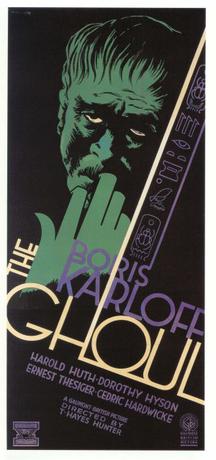Plot
Professor Henry Morlant, a great Egyptologist, thinks that the ancient jewel which he calls the "Eternal Light" will give him powers of rejuvenation if it is offered up to the ancient Egyptian god Anubis. But when Morlant dies, his servant Laing steals the jewel. While a gaggle of interlopers, including a disreputable solicitor and a fake parson, descend on the Professor's manor to investigate or steal the jewel for themselves, Morlant returns from the dead ("when the full moon strikes the door of my tomb", he predicted before dying) to kill everyone who has betrayed him.
Release and preservation
Loosely based on a 1928 novel by Frank King (and subsequent play by King and Leonard J. Hines), The Ghoul was produced by Gaumont British and released in the UK in August 1933. Release in the US followed in January 1934, with a reissue in 1938. The film was financially successful in the UK, but performed disappointingly in the US. [1] The only film made during a brief contract dispute with Universal Studios, The Ghoul also marked the first time in over two decades that Karloff had acted in Britain and the British film industry. [2]
Subsequently, the film disappeared and was considered to be a lost film. In 1969, collector William K. Everson located a murky, virtually inaudible subtitled copy, Běs, in then-communist Czechoslovakia. Though missing eight minutes of footage including two violent murder scenes, it was thought to be the only surviving copy of the film. Everson had a 16mm copy made and for years made it available to film societies in England and the United States, including a screening at The New School in New York City in 1975 on a Halloween triple bill with Lon Chaney in The Monster and Bela Lugosi in The Gorilla . Subsequently, The Museum of Modern Art and Janus Film made an archival negative of the Prague print and it went into very limited commercial distribution.
In the early 1980s, a disused and forgotten film vault at Shepperton Studios, its door blocked by stacked lumber, was cleared and yielded the nitrate camera negative of the film in perfect condition. The British Film Institute took possession of the film, new prints were made, and the complete version aired on Channel 4 in the UK. However, the official VHS release from MGM/UA Home Video was of the mutilated Czech copy. In 2003, MGM/UA released the fully restored version of the film on DVD. [3] It was subsequently released in the United Kingdom by Network Distributing, in restored DVD and Blu-Ray editions featuring a new commentary by Kim Newman and Stephen Jones.
The Ghoul was shown on the MeTV show Svengoolie on March 19, 2022.
This page is based on this
Wikipedia article Text is available under the
CC BY-SA 4.0 license; additional terms may apply.
Images, videos and audio are available under their respective licenses.
